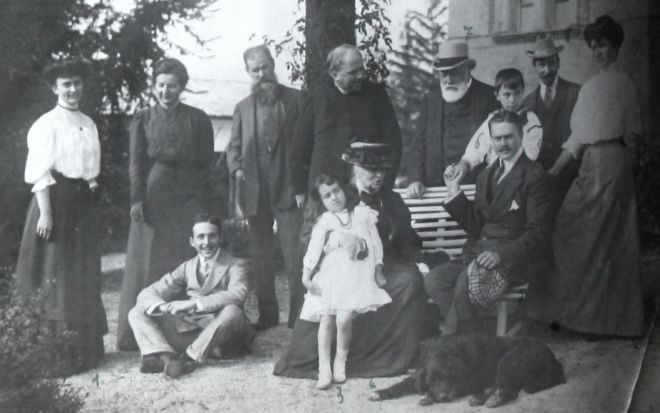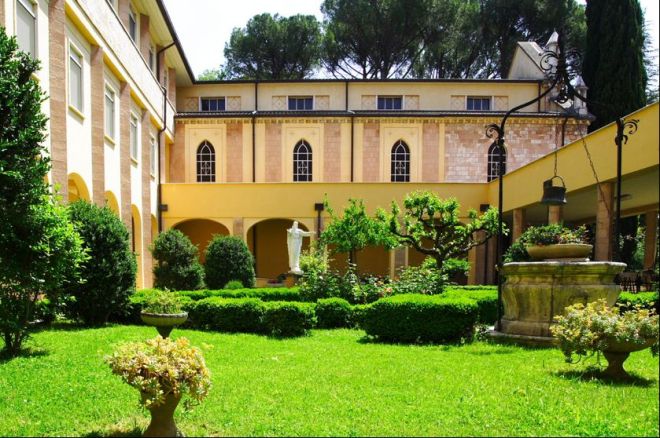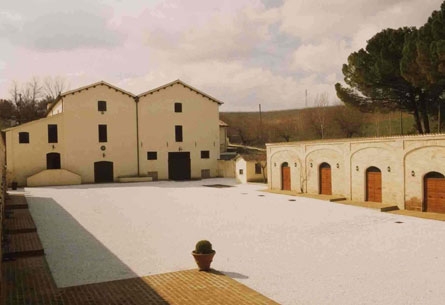By Carol Cofone
In our last post we examined how the Boncompagni Ludovisi in the latter part of the 19th century came into some spectacular properties in central and north Italy. Marriages of a daughter, a granddaughter and a grandson of Rodolfo, Prince of Piombino (VIIII) from 1883-1911, increased still further the number of impressive case at the family’s disposal. These additions included a villa at Pelago in Tuscany, another (massive) villa at Bagnarola di Budrio near Bologna, a palazzo and villa at Merate in Lombardy, and a palazzo at Varallo Sesia in the Piedmont region.
Then there is the villa ‘La Quiete’ at Foligno in Umbria, closely associated with Agnese Borghese, who soon after her 18th birthday married Rodolfo Boncompagni Ludovisi on 31 May 1854. But this villa was not an ancestral Borghese family possession. Rather it came to the Boncompagni Ludovisi through Agnese’s own deep-seated desire, one which inspired her search for a summer home near Foligno.
Their son Ugo Boncompagni Ludovisi (1856-1935) describes that search, which began just a year after the couple’s wedding, in his memoir Ricordi di mia Madre (1921) [translation here and below by C. Cofone]:
“In the summer of 1855 my parents made a big trip; they left Rome on June 14. At this time, few could give themselves this pleasure. I once saw a short diary of the trip, but I cannot find it. They crossed Umbria to go to Florence, where my Grandparents Piombino were [i.e., Antonio (III) Boncompagni Ludovisi, Prince of Piombino since 1841, and Guglielmina Massimo]. I believe the choice of road was determined by the fact that in that year cholera meandered around Italy.”

Antonio (III) Boncompagni Ludovisi (1808-1883), Prince of Piombino (VII) from 1841. Pope Pius IX personally exiled him in 1861 for his public support of King Victor Emmanuel II. Made a Senator that same year of the Kingdom of Italy, Antonio spent most of the rest of his life outside Rome.
“I recount that, passing through Narni, they were given a large lunch by the Count [Giuseppe] and Countess [Marianna] Catucci, the Countess was a Malatesta, and very attached to my Grandmother Piombino in friendship. Lunch was a parade; also taking part was the Monsignor-Delegate [sc. to Rieti in the Papal States], [Achille] Apolloni, later Cardinal. The [Papal] Delegates were the Prefects of the time, the provinces were small, and corresponded very nearly to our mid-level districts (circondari).”
“I also recount, and I want to note that, arriving at Foligno, they passed before the entrance to the large family estate ‘Case Vecchie’. And my mother in her diary noted: ‘I would love so much to have a residence in this place!’ Words that would seem a prophecy, and that came true almost by coincidence thirteen years later. How great a part of her life my mother would spend there, how many memories it arouses in us, how many of her own desires, she left there!”
It should be noted that the Case Vecchie was the tenuta owned by Rodolfo’s father Antonio, and that in the third generation Ugo was to take great interest in it.
After he completed his schooling, in 1884, Ugo returned to Foligno, and established the winery Scacciadiavoli in the heart of the Montefalco appellation. There he was among the first to practice modern wine making techniques. The name, which means “cast out the devils”, refers to a nineteenth century exorcist who lived nearby. The Scacciadiavoli estate is still thriving today.

Top two images above, the Cantina Scacciadiavoli, founded by Principe Ugo Boncompagni Ludovisi in 1884. The wine’s seal (bottom image) features the Boncompagni Ludovisi coat of arms. In fact, the metal columns that support the first floor of the winery bear Ugo’s monogram.
It may well be that the emotional connection the Boncompagni Ludovisi family had with land around Case Vecchie encouraged them to put down roots at Foligno. Here Ugo recounts how his mother Agnese found, purchased and settled in at La Quiete:
“And here I should note a fact that is so connected with all of my parents’ subsequent life. My Mother, whose health was declining after having brought five children into the world, was not happy summering in Albano [Laziale]. That climate did not seem to agree with her. She also wanted a country estate where my Father, who always loved agriculture, could take an interest, a welcome employment.”
“After a fruitless search in Marche, they saw, among other properties, not far from Treia, ‘La Quiete‘ that belonged then to the heirs of Count Lavinio Spada (1801-1864), a great friend of the Borghese family. They did not like it, I think, because they thought it too small.”

The Casato of the Villa Spada at Treia, known as ‘La Quiete’. Constructed in 1820 (with Giuseppe Valadier as the architect) it has been abandoned for the last 30 years.
Ugo continues in I Ricordi: “Instead [Rodolfo and Agnese] bought, near Foligno, a very shabby old villa from Count Aluffi of Rieti, who wanted to get rid of it. The exterior had no fine lines, but inside the villa had some good rooms with beautiful stucco vaults and grand porches. The villa was surrounded by twenty acres of land, and these attracted my Father; not far away was ‘Case Vecchie’, the beautiful estate that belonged then to my Grandfather. It was my Mother who made the purchase, and I think in memory of the Villa Spada she had seen before, gave it the name ‘La Quiete.’

Villa ‘La Quiete’ 20 October 1907. Standing behind center of bench (with hat) is Rodolfo Boncompagni Ludovisi, and seated at center is his wife Agnese Borghese, with granddaughter Maria Campello della Spina (1902-1987) on lap. Standing behind Agnese, in clerical garb, is her son Ugo (1856-1935). Also pictured: standing at far right, Ugo’s daughter (from first marriage) Guglielmina (1881-1973), who married Pompeo Campello della Spina (1875-1927) in 1900. Standing at far left, Ugo’s daughter (from second marriage) Teresa (1889-1969); sitting, on right of bench, his son Francesco (1886-1955), holding the hand of Guglielmina’s son Lanfranco Campello (1901-1969). Directly to the right of the boy is the Boncompagni Ludovisi family agent, Sig. Rocchi. Collection of HSH Prince Nicolò and HSH Princess Rita Boncompagni Ludovisi, Rome.

At La Quiete ca. 1918, Francesco Boncompagni Ludovisi, Prince of Piombino (IX), driving family in carriage, with son Gregorio (1910-1988) seated at center
The photos of the Boncompagni Ludovisi at their Foligno villa in the early 1900s stand in such startling contrast to these modern images of the much-expanded La Quiete, which has served as seminary, retreat house and source of hospitality in the time since it passed from the hands of the Boncompagni Ludovisi in the mid-20th century.

Three images above: the ex-Boncompagni Ludovisi “Villa La Quiete” (Foligno) in its present incarnation as a “Casa per ferie” administered by the Sacred Heart Fathers (Dehonians) since WW II. Credits: Tommaso Savoia
There are many stories to be told about La Quiete, and future posts will do so. But for now, we end where we began in Part I of this post, with Rodolfo Boncompagni Ludovisi at La Quiete in 1909. We see him holding that umbrella over his family—perhaps symbolic of his increasing difficulties in sheltering them, but also demonstrative of his unstinting desire to do so.

Four generations of the Boncompagni Ludovisi posing in 1909 at their villa La Quiete, near Foligno. Generation I (fourth and fifth to right): Rodolfo (1832-1911) and Agnese (1836-1920) Boncompagni Ludovisi. II (furthest left): their daughter Guendalina (1859-1942); III (seated): Nicoletta Prinetti Castelletti (1891-1931), wife of their grandson Francesco Boncompagni Ludovisi (1886-1955); and IV (in arms): that couple’s daughter Laura (1908-1975). Collection of HSH Prince Nicolò and HSH Princess Rita Boncompagni Ludovisi, Rome.
About the author: Carol Cofone is an undergraduate student at Rutgers University, pursuing a second degree in Italian. She is a recipient of the 2013 Rutgers Academic Excellence Award. She received her original degree from Syracuse University. She works in advertising as a Planner on brands such as Aetna, Accenture and the San Francisco Opera Guild. While at Ogilvy, she led the effort on the Dove “Real Beauty” strategy. She also enjoys ballet, and recently danced in Keigwin + Co’s Bolero at the Two River Theater Company.






Leave a comment